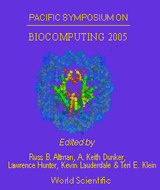Chaintweak: sampling from the neighbourhood of a protein conformation
Singh R, Bergert B
Computer Science and Artificial Intelligence Laboratory, Massachusetts Institute of Technology, Cambridge, MA 02139, USA. rsingh@mit.edu
Pac Symp Biocomput. 2005;:52-63.

Abstract
When searching for an optimal protein structure, it is often necessary to generate a set of structures similar, e.g., within 4A Root Mean Square Deviation (RMSD), to some base structure. Current methods to do this are designed to produce only small deviations (< 0.1A RMSD) and are inefficient for larger deviations. The method proposed in this paper, ChainTweak, can generate conformations with larger deviations from the base much more efficiently. For example, in 18 seconds it can generate 100 backbone conformations, each within 1-4A RMSD of a given 45-residue conformation. Moreover, each conformation has correct bond lengths, angles and omega torsional angles; its phi-psi angles have energetically favorable values; and there are rarely any backbone steric clashes. The method uses the insight that loop closure techniques can be used to perform compensatory changes of dihedral angles so that only a part of the conformation is changed. It is demonstrated, using decoys from the Decoys 'R Us data-set, that ChainTweak can be used to construct good decoys. It also provides a novel and intuitive way of analyzing the energy landscape of a protein. In addition, ChainTweak can improve the accuracy and performance of the loop modeling program RAPPER by an order of magnitude (1.1 min. vs. 36 min. for an 8-residue chain).
[Full-Text PDF] [PSB Home Page]